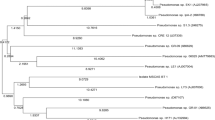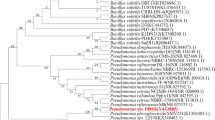Abstract
HPLC and HPLC-MS are the fastest and most accurate techniques for analysis of organic phosphorus pesticide (OPP) at the present time. Using these techniques, 14 strains of methamidopho (MAP) degrading-bacteria from the area contaminated with MAP have been identified. The results from HPLC and HPLC-MS analyses showed that the highest degradation rate was 73% after 7 days. In order to determine what metabolites will be formed after degradation, a key issue that has been neglected for a long time, we used (31P) NMR to track the degradation process. The results showed that different strains produced different metabolites. Ten strains were divided into three groups (groups A, B and C) by their metabolic profiling. Strains in group A degraded MAP into phosphor acid by breaking down all P–N, P–O and P–S bonds in 7 days. Strains in groups B and C had only broken down partially P–N and P–S bonds at the same time. Therefore, the bacterial strains in group A had a greater application potential than the other two groups. In addition, most metal phosphates are unsolvable in water. The analysis of X-ray showed, that the phosphate radicals generated by bacterial degradation induce crystallogenesis of heavy metal salts in water phase and also cause the chemical sedimentation of their crystals. Furthermore, these crystals are hydrogen phosphates. The results suggested that the MAP-degrading bacteria could be used for cleaning up not only the organic phosphorous pesticide contamination but also the phosphorous and heavy metal contamination in water environment simultaneously.
Similar content being viewed by others
References
Abou-Arab, A. A. K. (2002). Degradation of organochloride pesticides by Meat Start in liquid media and fermented sausage. Food and Chemical Toxicology, 40, 33–41.
Aislabe, J., & Lloyd-Jones, G. (1995). A review of bacterial degradation of pesticide. Australian Journal of Soil Research, 33, 925–942.
Chen, R. -Y., & Liu, L. -Z. (1995). Organophosphorus pesticides (pp. 117–120). Shanghai: Shanghai Science and Technology Press.
Cupta, A., Kaushik, C. P., & Kaushik, A. (2000). Degradation of hexachlorocycylohexane (HCH; a,b,g,d) by Bacillus circulans and Bacillus brevis isolated from soil contaminated with HCH. Biology & Biochemistry, 1803–1805.
McCalley, D. V. (2003). Rationalization of retention and overloading behavior of basic compounds in reversed-phase HPLC using low ionic strength buffers suitable for mass spectrometric detection. Analytical Chemistry, 75, 3404–3410.
Ellis, B. M. L. (2000). Environmental biotechnology informatics. Current Opinion in Biotechnology, 11, 232–235.
Janssen, D. B., Oppentocht, J. E., & Poelarends, G. J. (2001). Microbial dehalogenation. Current Opinion in Biotechnology, 12, 254–258.
Kazt, I., Kosoretz, C. G., Mandelbaum, R. T., & Green, M. (2001). Atrazime degradation under denitrifying conditions in continuous culture of Pseudomonas ADP. Water Research, 13, 3272–3275.
Lopez, L., Pozo, C., Rodelas, B., Calvo, C., Juarez, B., Martinez-Toledo, M. V. et al. (2005). Identification of bacteria isolated from an oligotrophic lake with pesticide removal capacities. Ecotoxicology, 14, 299–312.
Schie, P. M., & Young, L. Y. (1998). Isolation and characterization of phenol-degrading denitrifying bacteria. Applied and Environmental Microbiology, 64, 2432–2438.
Stenle, P., Stucki, G., & Stettler, R. (1998). Aerobic mineralization of 2,6-dichlorophenol by Ralstonia sp. strain RK1. Applied and Environmental Microbiology, 64, 2566–2571.
Author information
Authors and Affiliations
Corresponding author
Rights and permissions
About this article
Cite this article
Lu, Y., Sun, X., Ji, SY. et al. Application of (31P) NMR in Analyzing the Degradation Efficiency of Organic Phosphorus Degrading-Bacteria. Environ Monit Assess 130, 281–287 (2007). https://doi.org/10.1007/s10661-006-9396-1
Received:
Accepted:
Published:
Issue Date:
DOI: https://doi.org/10.1007/s10661-006-9396-1




